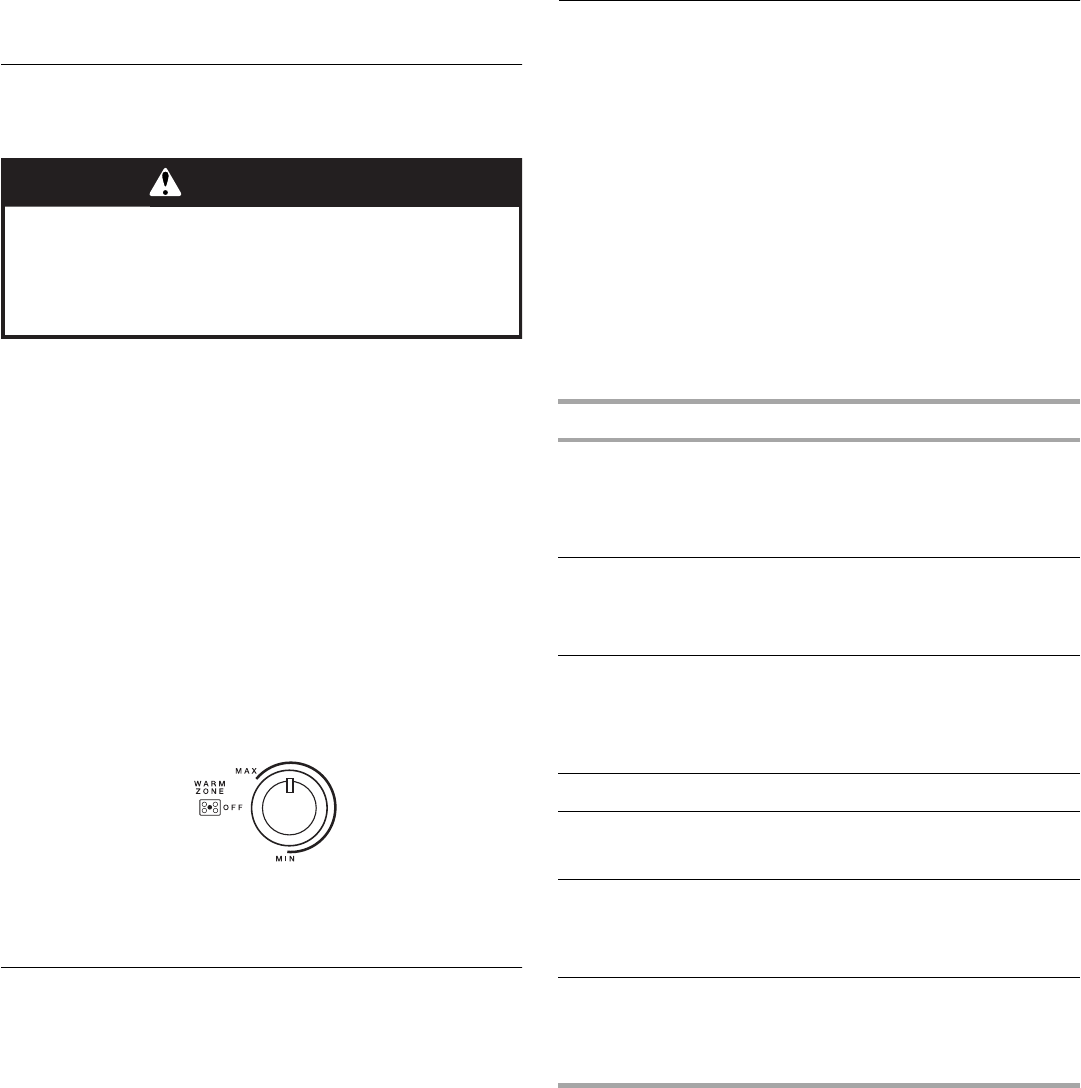
6
To use:
1. Turn the Simmer control knob to the SIMMER position.
The indicator light will glow.
2. Push in and turn the left front control knob to a setting
between LO and 5.
Select LO for a low simmer or when using lids and 5 for a high
simmer or when not using lids.
On some models, select either the Single or Dual Zone
settings. See “Dual Watt Element” section.
3. Turn the Simmer control knob back to the NORMAL burner
setting when finished cooking. The indicator light will go out.
Warm Zone Element
(on some models)
Use the Warm Zone Element to keep cooked foods warm. One
hour is the recommended maximum time to maintain food
quality.
Do not use it to heat cold foods.
The Warm Zone Element can be used alone or when any of the
other surface cooking areas are being used, and can be set from
MIN to MAX for different levels of heating.
The Warm Zone Element area will not glow red when cycling on.
However, the hot surface indicator light will glow as long as the
Warm Zone Element area is too hot to touch.
■ Use only cookware and dishes recommended for oven and
cooktop use.
■ Cover all foods with a lid or aluminum foil. When warming
baked goods, allow a small opening in the cover for moisture
to escape.
■ Do not use plastic wrap to cover food. Plastic wrap may melt.
■ Use pot holders or oven mitts to remove food.
To Use:
1. Push in Warm Zone knob to desired setting.
2. Turn knob to OFF when finished.
Home Canning
When canning for long periods, alternate the use of surface
cooking areas, elements or surface burners between batches.
This allows time for the most recently used areas to cool.
■ Center the canner on the grate or largest surface cooking
area or element. Canners should not extend more than
1" (2.5 cm) outside the cooking area.
■ Do not place canner on 2 surface cooking areas, elements or
surface burners at the same time.
■ On ceramic glass models, use only flat-bottomed canners.
■ On coil element models, the installation of a Canning Unit Kit
is recommended. If a kit is not installed, the life of the coil
element will be shortened. See “Assistance or Service” for
ordering instructions.
■ For more information, contact your local U.S. Government
Agricultural Department Extension Office. In Canada, contact
Agriculture Canada. Companies that manufacture home
canning products can also offer assistance.
Cookware
IMPORTANT: Do not leave empty cookware on a hot surface
cooking area, element or surface burner.
Ideal cookware should have a flat bottom, straight sides, a well-
fitting lid and the material should be of medium-to-heavy
thickness.
Rough finishes may scratch the cooktop. Aluminum and copper
may be used as a core or base in cookware. However, when used
as a base they can leave permanent marks on the cooktop or
grates.
Cookware material is a factor in how quickly and evenly heat is
transferred, which affects cooking results. A nonstick finish has
the same characteristics as its base material. For example,
aluminum cookware with a nonstick finish will take on the
properties of aluminum.
Use the following chart as a guide for cookware material
characteristics.
WARNING
Food Poisoning Hazard
Do not let food sit for more than one hour before or
after cooking.
Doing so can result in food poisoning or sickness.
COOKWARE CHARACTERISTICS
Aluminum ■ Heats quickly and evenly.
■ Suitable for all types of cooking.
■ Medium or heavy thickness is best for
most cooking tasks.
Cast iron
■ Heats slowly and evenly.
■ Good for browning and frying.
■ Maintains heat for slow cooking.
Ceramic or
Ceramic glass
■ Follow manufacturer’s instructions.
■ Heats slowly, but unevenly.
■ Ideal results on low to medium heat
settings.
Copper
■ Heats very quickly and evenly.
Earthenware ■ Follow manufacturer’s instructions.
■ Use on low heat settings.
Porcelain
enamel-on-
steel or cast
iron
■ See stainless steel or cast iron.
Stainless steel
■ Heats quickly, but unevenly.
■ A core or base of aluminum or copper
on stainless steel provides even
heating.
